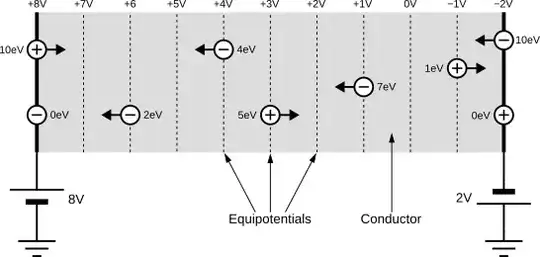Don't confuse potential with potential energy. They are intimately related, as I'll show below, but it will require some explaining. Bear with me! This diagram will help distinguish and relate them:

Here we have two conductive plates, separated by some distance, and having some conductive material between them. This could represent a resistor, for example. I have applied fixed potentials of +8V and −2V at each end, using cells, for a total potential difference of 10V from end to end.
Mobile negative charges in the grey material would be electrons. They are represented by circled "−" symbols. They each have charge \$-q\$, where:
$$ q=1.6\times 10^{-19} \rm{C} $$
Even though there would be no mobile positive electric charges in the conductor (unless the material were an electrolyte or something else that actually can contain mobile positive charge carriers), they are represented here by the circled "+" symbols. They have charge \$+q\$.
The entire grey area will have an electric field within in it, due to the 10V potential difference applied to the end plates. If the plates were, say, 10cm apart, that electric field would have strength \$E\$ throughout:
$$ E = \frac{\Delta V}{d} = \frac{(+8V) - (-2V)}{0.1m} = \frac{10V}{0.1m} = 100\frac{V}{m} $$
Notice how it's the potential difference between the two ends that we are interested in. That means we could apply potentials 100V higher at each end, for +108V and +98V, and nothing inside the material changes! Keep that in mind as we go on.
You could use this \$E\$ to calculate the force \$F\$ on each charge. Here, \$Q\$ is the charge (either \$-q\$ or \$+q\$ for my hypothetical charges above):
$$ F=EQ $$
Importantly, the sign of \$F\$ depends on the sign of \$Q\$. This determines the direction of force (and consequently acceleration), and so the positive charges are accelerated in the opposite direction to the electrons. That force (and direction of movement) is represented by the arrows attached to each charge.
Here's the answer to your question, then: electrons travel from low potential to high. That's true for anything that isn't a source of energy. For sources like batteries or solar panels, the story might be different, so for now we are considering only passive elements like resistors, wires and so on.
Understand that even though the "voltage" or "potential" is clearly higher (more positive) on the left here, the potential energy possessed by a charge (relative to same-polarity charges at the other end) depends on the charge's polarity.
Each electron at the right-hand plate has 10eV more potential energy than electrons found at the left hand plate. However, for positive charges it's the other way around; each positive charge at the left plate has 10eV more than positive charges at the right plate.
That's because each charge "falls" in the electric field in the direction of the force it experiences, in the same way that positive mass always falls in a gravity field. You mentioned the ball on a hill, and this can help. A ball at the top of a hill has more gravitational potential energy than it would have at the bottom. When released, it will always roll downhill, and will therefore always lose potential energy. As it rolls, it accelerates, but friction will prevent it from attaining much speed, and in the end, almost all of the potential energy it started with will have been lost to the grass and brush it rolled over, or trees it collided with. It will reach the bottom with no potential energy, and almost no kinetic energy either. This analogy does't have balls with negative mass, though, so it's not perfect.
In the electrical realm, we are dealing with electric fields, not gravitational, and the direction of "falling" is defined by the polarity of the charge. Positive charges "fall" towards lower potentials, as in the gravity analogy, where a positive mass falls to a lower elevation, but electrons, with their negative charge, "fall" towards higher potentials. Perhaps it might make more sense to think of electrons falling "upwards". It's entirely up (or down) to you, how you picture this.
Regardless of polarity, all charges "fall" to a place of lower potential energy, but depending on the charge polarity, that place can have either higher or lower electrical potential, or "voltage".
Just for completeness, since charges always "fall", and always lose potential energy (I say always, but there are of course ways to increase a charge's potential energy, which is another story), that energy must be donated to the environment, to comply with the law of conservation of energy. In a resistor, a charge's potential energy is converted to heat. In a motor, most of the energy would become kinetic (motion) energy. For an LED or lamp, some would become light.
The algebra for current and voltage is charge-agnostic. It works, and is consistent, whether the actual participating charges are positive or negative. However, it's easier to envisage positive charges falling to a lower potential, since we are all familiar with masses falling downwards to a lower position. That's why we use "conventional" current, in which we treat all charges as positive, flowing from high to low potential, even though we are well aware that the actual participating, moving charges are electrons going the other way.
